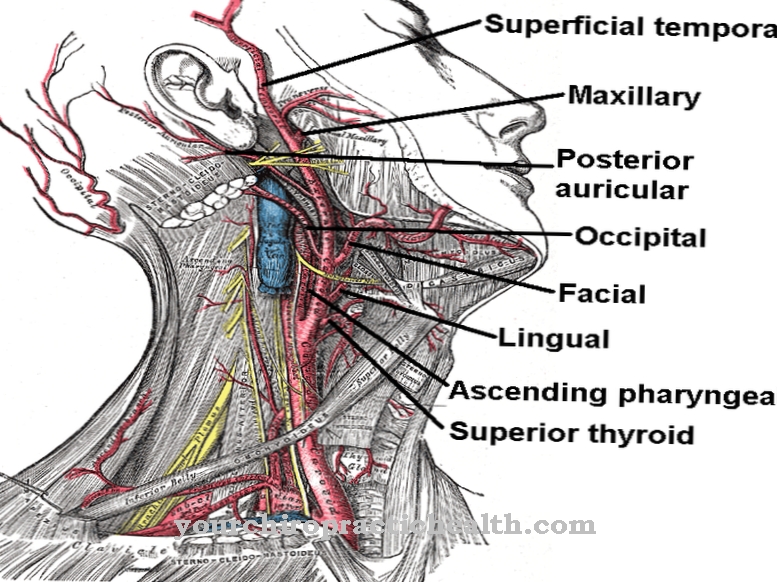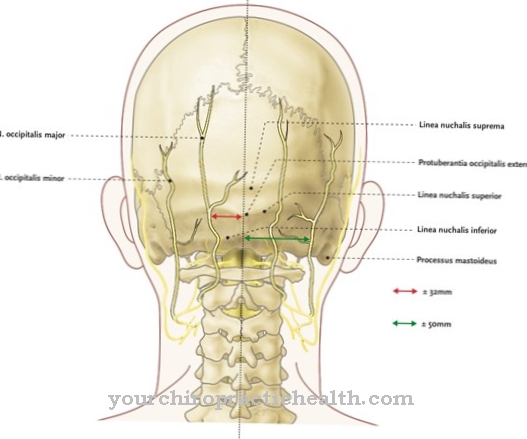At the Psoas minor muscle it is a special skeletal muscle. The muscle is one of the inner muscles of the hip. What is special about the psoas minor muscle is that only some people have the muscle. So it is an inconstant muscle that only around 50 percent of all people have. In the medical literature, the psoas minor muscle is also considered to be a component of the iliopsoas muscle in some cases.
What is the psoas minor muscle?
The medical name musculus psoas minor means something like 'small lumbar muscle‘. The psoas minor muscle is a so-called skeletal muscle that is located in the area of the lower extremity. Specifically, the psoas muscle is located in the anterior layer of the posterior muscles of the hip.
Not everyone has the psoas minor muscle. Instead, it is only present in around half of all people. The psoas minor muscle forms a functional unit with the psoas major muscle. This is the large lumbar muscle. Another component of this functional unit is the iliopsoas muscle, the lumbar and iliac muscle.
The psoas muscle arises from the twelfth thoracic vertebra and the first lumbar vertebra. The psoas muscle has a long tendon that extends to a fascia on the psoas major muscle. In addition, the psoas minor muscle radiates to the iliopectineus arc. The psoas minor muscle is innervated by the anterior branches of the so-called lumbar nerves number one to three.
Anatomy & structure
The beginning of the psoas minor muscle lies in the body of the twelfth thoracic vertebra and the first lumbar vertebra. The psoas minor muscle has a long tendon that extends into a special muscle band called the iliac fascia. This muscle bandage encloses the psoas minor muscle together with the iliac muscle and the large lumbar muscle. As a result, the psoas minor muscle fits into a curved ligament, the arcus iliopectineus. This ligament is located between the eminentia iliopubica on the pubic bone and the inguinal ligament (medical term ligamentum inguinale).
Mammals with four legs also have a psoas minor muscle. This does not originate in the lumbar iliac muscle, but in a tiny hump in the area of the iliac bone, the so-called tuberculum musculi psoas minoris. The psoas minor muscle is particularly long and narrow and is located near the hip joint. It has a ventral course that is based on the Iliopsoas. The two muscles together form the subgroup known as the inner hip muscles.
The long tendon of the muscle connects to the eminentia iliopubica and the pecten ossis pubis. There are also several connections to the iliac fascia. The psoas minor muscle is innervated directly via the branches of the lumbar plexus. In principle, the psoas minor muscle is located in the depths of the abdomen. For this reason it can hardly be felt from the outside. In many cases, people who do not have the psoas minor muscle have a delicate ligament or an extension of the iliopsoas.
Function & tasks
The tasks of the psoas minor muscle are rather limited. Since it is a very small lumbar muscle that is not present in all people, its importance is not particularly great. The psoas minor muscle alone has almost no effect.
It only inclines to one side when flexed on one side and flexes the lumbar spine when contracted on both sides. In doing so, however, it works with other muscles in the area. First and foremost, it supports the ilipsoas muscle. Since the psoas minor muscle is an internal hip muscle, it also stabilizes the pelvis and the hip joint. However, its contribution to various movements is rather small overall.
Diseases
Various diseases and complaints are possible in connection with the psoas minor muscle. These differ from person to person in their severity, the severity of the symptoms and the individual clinical picture.
Psoas minor syndrome, for example, is a disease in which the psoas minor muscle is very rigid and can hardly be moved. In healthy people, the muscle originates in the pelvis. In the sick patient, the tendon often extends to the so-called femur. For this reason it is very susceptible to heavy loads on the lot. Often it is not only the hip that is restricted in terms of movement. The spine can also be affected by poor posture.
In addition, the psoas minor muscle is in some cases associated with lower abdominal pain. Young women are often affected by these complaints. The symptoms are sometimes classified as appendicitis, even though it is actually psoas minor syndrome. In such a case, the symptoms can be easily alleviated by cutting the appropriate tendon. Any discomfort or pain originating from the psoas minor muscle area should be referred to a suitable doctor as soon as possible. This then initiates suitable therapeutic measures.
























.jpg)



